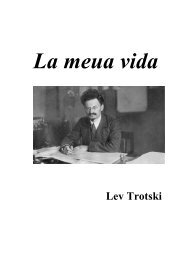Leon Trotsky: 1905
Leon Trotsky: 1905
Leon Trotsky: 1905
You also want an ePaper? Increase the reach of your titles
YUMPU automatically turns print PDFs into web optimized ePapers that Google loves.
<strong>Leon</strong> <strong>Trotsky</strong>: <strong>1905</strong>: CHAPTER 3 -- The Peasantry and the Agrarian Question<br />
the creditors of Tsarism: every member of a peasant family spends 19.5 roubles per annum on food, 3.8<br />
roubles on lodging, 5.5 roubles on clothing, 1.4 roubles on other material needs and 2.5 roubles on<br />
spiritual and intellectual needs! A single skilled American worker spends, directly and indirectly, as<br />
much as two Russian families of six members each. Yet to cover this type of expenditure, which no state<br />
moralist could call excessive, the peasantry's income from agriculture is more than a billion roubles short<br />
each year. Cottage industries bring in about zoo million roubles' profit to the villages. If this sum is<br />
deducted, peasant agriculture shows an annual deficit of 850 million roubles, which is precisely the sum<br />
which the state fiscal organization snatches each year from the hands of the peasantry.<br />
In our description of peasant agriculture we have until now ignored the economic differences between<br />
different regions, which, in actual fact, are of the greatest significance and have found powerful<br />
expression in the forms of the agrarian movement (see the chapter entitled The Peasant Riots). If we<br />
concentrate on the fifty provinces of European Russia, and set aside the northern forest strip, the<br />
remainder of the area can, from the viewpoint of peasant agriculture and of economic development in<br />
general, be divided into three large regions:<br />
1. The industrial region, including Petersburg province in the north and Moscow province in<br />
the south. This northern capitalist area, dominated by Petersburg and Moscow, is<br />
characterized by factories (especially textiles), cottage industries, flax cultivation, and<br />
commercial agriculture -- in particular, market gardening. Like all other industrial regions,<br />
this area does not grow sufficient grain for its needs and is obliged to import it from the<br />
south.<br />
2. The southeastern region adjoining the Black Sea and the lower reaches of the Volga: the<br />
Russian America. This area, in which serfdom was almost non-existent, played the role of a<br />
colony in relation to the central part of Russia. So-called "wheat factories," using modern<br />
agricultural machinery and exporting their grain to the industrial region in the north and to<br />
foreign countries in the west, sprang up rapidly in the free expanses of the steppe, attracting<br />
a large number of immigrants. Parallel with this there took place a transfer of labor power to<br />
the processing industries, the flourishing of heavy industry and feverish urban growth. In<br />
this area, the differentiation within the peasant community goes extremely deep, the peasant<br />
farmer standing at one end of the scale and the agricultural proletarian, in many cases an<br />
immigrant from the black- earth provinces, at the other.<br />
3. Between the old industrial north and the new industrial south there lies the broad strip of<br />
black earth, the Russian India. Its population, which was relatively dense even under<br />
serfdom and was engaged in agriculture in its entirety, lost 24 per cent of its land area as a<br />
result of the reform of 186i, the best, essential parts of the peasants' allotments being turned<br />
over to the landowners. Land prices rose rapidly, the landlords engaged in a purely parasitic<br />
economy, partly cultivating their lands with the peasants' stock and partly leasing them to<br />
the peasants, who were thus bound inescapably to slavish rent conditions. Hundreds of<br />
thousands of peasants are leaving this region for the industrial area in the north and for the<br />
south, where they bring down the level of labor conditions. In the black-earth strip there is<br />
neither large-scale industry nor capitalist agriculture. Here, the capitalist farmer cannot<br />
compete with the pauper tenant-farmer, and the steam plow is defeated in the struggle with<br />
the physiological resilience of the muzhik, who, having paid as rent not only the entire profit<br />
on his "capital" but also a large part of his wages, exists on a diet of flour mixed with wood<br />
http://www.marxists.org/archive/trotsky/works/<strong>1905</strong>/ch03.htm (4 of 7) [06/06/2002 13:41:35]



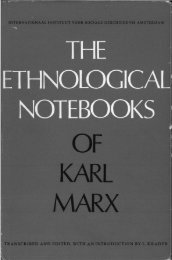

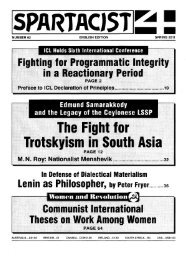

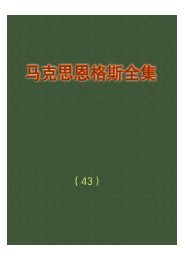
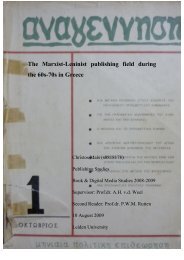


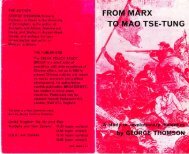

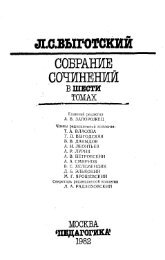
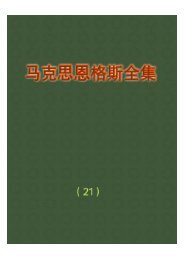
![tyf Enf=O=n]lgg](https://img.yumpu.com/47584932/1/190x245/tyf-enfonlgg.jpg?quality=85)
